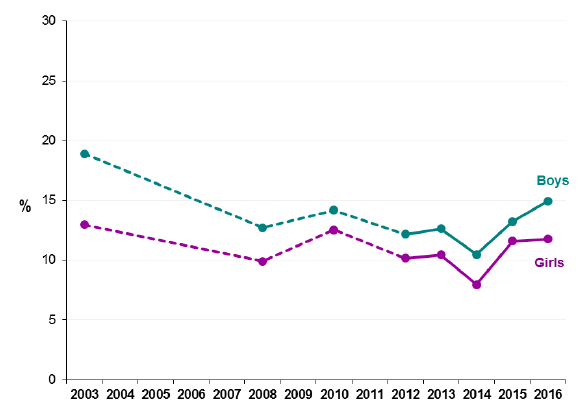Obesity indicators 2017
Annual report of the latest results for the indicators selected to monitor progress of our Prevention of Obesity Route Map (2010).
This document is part of a collection
Child sedentary activity
Indicator Source: Scottish Health Survey
Latest Results
- In 2016, children (aged 2 to 15 years) spent a mean time of 2.1 hours sitting watching a television or other screen [11] on weekdays and 3.0 hours on weekend days (excluding time at school).
- The rates for all children have been relatively stable since 2003, at around 2.0 to 2.3 mean hours on weekdays and 2.7 to 3.0 hours on weekend days.
- Boys spent more time sitting watching a television or other screen than girls, particularly at weekends when the mean times recorded were 3.1 hours for boys and 2.9 hours for girls.
- The proportion of children spending four or more hours sitting watching a television or other screen on an average day (excluding time in school) in 2016 was 13% (15% for boys, 12% for girls). This was a slight increase compared to 2014 and 2015 (9% and 12% respectively), and remains lower than the proportion in 2003 (16%).
Figure 12: Proportion of children (2-15) spending four or more hours sitting watching TV/other screen, by gender, 2003-2016

About This Indicator
Desired Outcome:
Increased energy expenditure.
Definition:
Time spent at a screen ( TV or other screen such as a computer, games console or handheld gaming device) on an average day (including weekdays and weekends) excluding time at school.
Relevant Route Map action:
Early years actions, specifically less sedentary activities for young children.
Geography available:
National.
Equalities data:
Breakdowns by equalities groups are possible but not all are available annually.
Rationale for including this indicator:
The aim of this indicator is to monitor the proportion of children engaging in sedentary behaviour such as hours spent sitting at screen on an average day.
Factors influencing this indicator:
- Choice of leisure activities.
- Availability of alternatives to screen-based activity.
- Safe outdoor spaces to play.
Contact
There is a problem
Thanks for your feedback